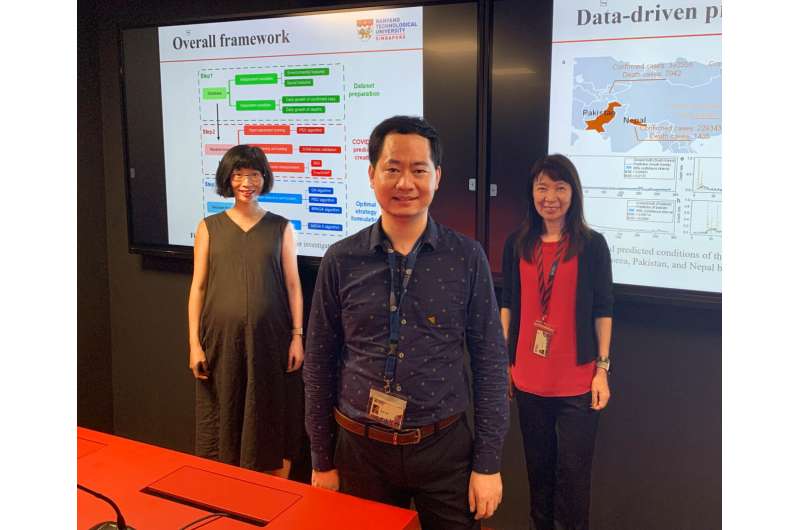
A team of scientists from Nanyang Technological University, Singapore (NTU Singapore) has developed a predictive computer model that, when tested on real pandemic data, proposed strategies that would have reduced the rate of both COVID-19 infections and deaths by an average of 72 percent, based on a sample from four countries.
The model, called NSGA-II, could be used to alert local governments in advance on possible surges in COVID-19 infections and mortalities, allowing them time to put forward relevant counter measures more rapidly.
Through the testing of NSGA-II in four Asian countries using data available from 1 January 2020 to 31 December 2020, the team demonstrated that it could have helped reduce the number of COVID-19 infections and deaths by up to 76 percent in Japan, 65 percent in South Korea, 59 percent in Pakistan, and 89 percent in Nepal.
The computer model achieved the result by recommending timely and country-specific advice on the optimal application and duration of COVID-19 interventions, such as home quarantines, social distancing measures, and personal protective measures that would help to thwart the negative impact of the pandemic.
The team also showed NSGA-II could make predictions on the daily increases of COVID-19 confirmed cases and deaths that were highly accurate, at a confidence level of 95 percent, compared to the actual cases that took place in the four countries over the past year.
Harnessing the power of machine learning, the research team developed NSGA-II by inputting large amounts of data on COVID-19 mortalities and infections worldwide that is available for the whole of 2020, helping it learn the dynamics of the pandemic. The research was reported in the peer-reviewed scientific journal Sustainable Cities and Society in August.
Assistant Professor Zhang Limao from NTU’s School of Civil and Environmental Engineering, who led the study, said: “The main goal of our study is to aid health authorities to make data-driven decisions in fighting the global COVID-19 pandemic. As we have observed in global efforts, there is no one-size-fits-all solution, and we hope our comprehensive program would be able to help governments tailor the solutions at an early stage to best fit their country’s needs at different stages of the pandemic. The critical knowledge discovered in historical data enables us to provide early warning, preparation, and prevention for crisis control and enhance the resilience of human societies.”
Co-author Professor May O. Lwin, Chair of NTU’s Wee Kim Wee School of Communication and Information, said: “As the epidemic continues progressing, there is a great deal of learning experiences from the global society regarding pandemic control strategies and effects. Governments need to continually refine their response plans for curbing the spread of the virus and to draw upon a suitable combination of policies and intervention strategies. These include a combination of quarantines, social distance measures, personal protective measures, and promoting vaccination and proactive citizen behaviors in everyday life, including work and travel modes, and engagement in social activities.”
Assistant Professor Yan Zhenzhen from NTU’s School of Physical and Mathematical Sciences, who co-authored the study, said: “Our research offers an opportunity to fully mine the valuable information in the accumulated data related to environmental and social dimensions of the COVID-19 pandemic. By applying our program, we have managed to create a prediction model that accurately estimates the daily infection rate and death at a high confidence level of 95% at the national scale.”
Early action is the key
As the pandemic progresses and the COVID-19 virus undergoes many mutations, it threatens the resilience of global society across every aspect of daily life, the environment, and the economy, and it requires the prompt and prioritized attention of policymakers worldwide.
The NTU-developed computer program could serve as a useful tool to help governments formulate strategies and interventions at an early stage to limit or even counter a predicted surge in cases, reducing infections and mortality rates.
Asst Prof Zhang added: “Alongside existing bioinformatics and medical methodologies for virus mechanism study, our program shows that data science is an approach that can provide advantages in battling the pandemic. The practical value of our program lies in two aspects. On one hand, it can well capture the transmission dynamics of the virus for an accurate prediction under consideration of environmental and social variables. On the other hand, it can systematically analyze and optimize the relevant factors on the targeted objectives for adaptive control.”
Prof Lwin added: “We selected Japan and South Korea for our analysis as these countries were two of the earliest to take measures and policies to control the pandemic. We hope the program will be especially useful in relatively less developed countries, as they face greater challenges on medical and economic fronts.
Asst Prof Yan added: “As our data analysis extends to encompass more and more of the pandemic’s history, the program could hopefully be used to assist health authorities in their decision-making to reduce COVID-19 risks for their populations.” The team is hoping to work with regional partners who will benefit from the predictive program.
Source: Read Full Article
